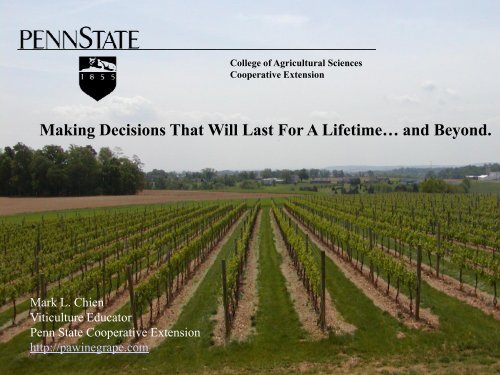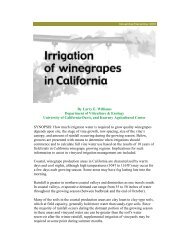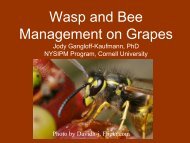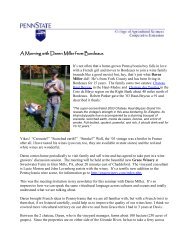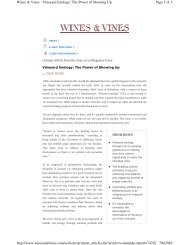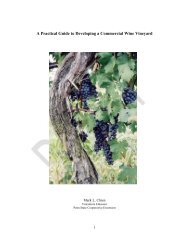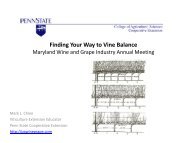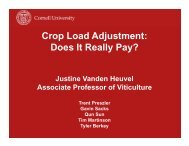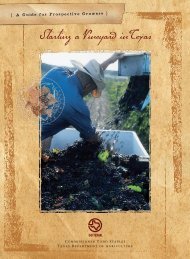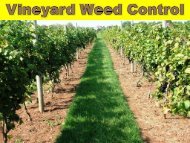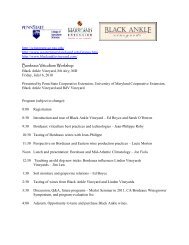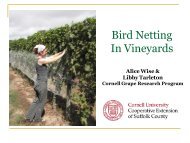Vineyard site selection, design, preparation, plant materials, planting ...
Vineyard site selection, design, preparation, plant materials, planting ...
Vineyard site selection, design, preparation, plant materials, planting ...
Create successful ePaper yourself
Turn your PDF publications into a flip-book with our unique Google optimized e-Paper software.
___________________________________________<br />
College of Agricultural Sciences<br />
Cooperative Extension<br />
Making Decisions That Will Last For A Lifetime… and Beyond.<br />
Mark L. Chien<br />
Viticulture Educator<br />
Penn State Cooperative Extension<br />
http://pawinegrape.com
Temperance Hill <strong>Vineyard</strong><br />
Willamette Valley, Oregon
Assumption:<br />
We wish to grow high quality<br />
hybrid or vinifera wines
Some Things to Do and Think About<br />
1. Why am I doing this? Will it last?<br />
2. Knowing what you do not know and asking how will I fill the<br />
knowledge gap?<br />
3. Who will do the work? Consultants, service companies or me…<br />
4. … if me then education is the key: read or go to school<br />
5. Visit vineyards and wineries, local and beyond …but be prepared with<br />
good, smart questions<br />
6. You’re doing it! Attend meetings, workshops, field days, etc.<br />
7. Examine thy:<br />
a. Wallet: do I have the money to do this well?<br />
b. Calendar/Datebook: do I have the time?<br />
c. Body: do I have the physical strength?<br />
d. Risk tolerance: fickle weather, birds, wine makers, consumers, etc.<br />
d. Heart: do I have the passion for a long-term project?<br />
e. Family: is my family on board with me?
Filling the knowledge gap with<br />
3 excellent how-to books:<br />
Available (PDF) now on PWGN: A Practical Guide to Developing a Commercial<br />
Wine <strong>Vineyard</strong>. By Mark Chien
Viticulture Information Resources List: books, web<strong>site</strong>s, periodicals; consultants, vendors, nurseries,<br />
educational resources, etc.
The pre-<strong>plant</strong> laundry list: better to ask the hard questions now …
Quality . . .<br />
• …in everything: grapes, winemaking, winery relationships, vineyard<br />
<strong>materials</strong> and equipment, personnel, etc.<br />
• …it’s the BEST marketing tool<br />
• …it’s the surest and fastest way to success and sustainability<br />
• …it will make your reputation<br />
• It’s more fun to have a good product that you can be proud of and<br />
others admire
Viticulture Quality Factors<br />
• Starts with knowing the wine type, style and price point<br />
• Site <strong>selection</strong> and evaluation: pick the land, don’t let it pick you<br />
• Terroir components: achieving a vine with correct size and balance<br />
• Only fully mature grapes can make fine wine<br />
• In cold areas, ripen the wood as well for cold hardiness<br />
• <strong>Vineyard</strong> <strong>design</strong>: vine density, spacing and yield per vine<br />
• The power of great viticulture: the garagistes<br />
• Strive for balance, harmony, uniformity, consistency
<strong>Vineyard</strong> Site Selection<br />
The Most Important Decision You Will Make<br />
45 mins
Wine Terroir<br />
• Terroir: it’s everywhere! Even in your flower pot.<br />
• But for vineyards, these matter the most . . .<br />
• Components of soil: the chemical, physical, and biological<br />
• Climate at 3 levels - macro, meso, micro<br />
• Plant <strong>materials</strong>: species, variety, clone, rootstock<br />
• Viticulture: what we add to the grapes<br />
• Wine making: what the wine maker does to shape the wine<br />
• How do you get fine wine terroir?
Why is this such a great vineyard?
Soil Features for Fine Wines<br />
• Excess soil moisture and nitrogen are the enemies of fine wines!<br />
• Our objective is to create a balanced vine according to <strong>site</strong> capacity<br />
and vine size. For this we need . . .<br />
• Well to excessively well-drained soils: TAW 2.5 to 4.5<br />
• Rock content up to 50%<br />
• Effective rooting zone of at least 18 inches<br />
• Low to moderate fertility (especially nitrogen!)<br />
• pH 5.5 to 6.5<br />
• Organic matter 2-4 percent<br />
• No physical or chemical impediments to root growth<br />
• For production vineyards: everything a step or two above
From <strong>Vineyard</strong> Site Selection, Wolf and Boyer
Looking into the crystal ball…<br />
…three important tools
Bedington<br />
Blairton (Arendtsville)<br />
Chester Manor Loam<br />
Berks-Bedington<br />
<strong>Vineyard</strong> Soils of Pennsylvania
But get the right person<br />
to interpret the numbers!<br />
Soil Chemistry: now is the<br />
time to analyze it and, if<br />
necessary, fix it!
Vectors for:<br />
• Tomato Ringspot Virus<br />
• Fanleaf Virus<br />
The Bad guys:<br />
Pathogenic nematodes: now is the time to survey and treat them!
Climatic Challenges: you are not in control<br />
• Continental climate: humid, wet, warm summers, very cold winters<br />
above Mason-Dixon<br />
• Freeze: LTE50, what is the threshold for injury? Varieties, seasons,<br />
soils, etc.<br />
• Spring and fall frosts (length of growing season)<br />
• Summer afternoon thundershowers, hail storms, lightning, drought<br />
• Harvest: hurricanes, low pressure systems<br />
• The past decade:<br />
– Fine: 2007, 2008, 2010<br />
– Poor: 2003, 2004, 2009, 2011<br />
• Impact: lack of uniformity and consistency in vineyard and products
Natives, hybrids and vinifera<br />
Native and cold hardy hybrids<br />
Hybrids and some vinifera<br />
Vinifera
Hilling up in the fall . . .<br />
. . . taking down in the spring >>
Annual rainfall from 1961 to 1990. Distribution is also important,<br />
especially between mid-August and October!
What are Ideal Macro-Meso Climate Conditions?<br />
• Enough winter rain to fully charge the soil with moisture<br />
• Not so cold as to damage grapevine tissue (vinifera 0F)<br />
• No late spring frost, enough sun and warmth to push vines through bloom<br />
• Some drying after bloom through fruit set to set berry size with mild stress<br />
• 1-2” of rain June-August, enough to sustain growth but not too much<br />
• Dry and sunny conditions in September/October, < 2” of rain each month<br />
• No early fall frost<br />
• Steady descent from cool to cold conditions in November and December<br />
• How often do all of these conditions occur? Never. Make adjustments.
Impact of Climate and Weather<br />
• What’s the difference?<br />
• Bud break and spring frost<br />
• Warm and wet increases disease and insect pressure<br />
• Wet exacerbates vegetative vigor which increases disease and hampers fruit<br />
ripening<br />
• Drought, hail, wind, etc.<br />
• Acclimation, low and fluctuations in winter temperature affect vine survival<br />
• Getting the fruit fully mature. Finding a cool <strong>site</strong> in a warm place or a warm<br />
<strong>site</strong> in a cool region. Ripen fruit in cool conditions on the outer limit of its<br />
ripening window.
Other Site Features<br />
• Absolute (ripening) and relative (frost and freeze) elevations<br />
• Local Topography<br />
– Aspect (orientation)<br />
– Slope<br />
• Trees<br />
– Black walnut and butternut<br />
– Birds, insects, disease, shade<br />
deer, wind<br />
• Neighbors (non-agricultural)<br />
– Cement, bricks, noise (yours, not theirs), etc.<br />
– Schools and businesses<br />
From <strong>Vineyard</strong> Site Selection, Wolf and Boyer
Fill the Knowledge Gap with the Right Experts!<br />
• Soil mapping - Alex Blackburn<br />
• Plant material specialist – James Stamp<br />
• Viticulturist – Lucie Morton<br />
• <strong>Vineyard</strong> development specialist – Nelson Stewart<br />
• Consultants from France and California<br />
• Harrisburg Area CC viticulture and enology program
On-line tools:<br />
• PSU <strong>Vineyard</strong>Map<br />
• USDA web soil survey<br />
• Cornell NY Site Evaluation System
Tony Wolf and John Boyer, Virginia Tech<br />
http://pubs.ext.vt.edu/463/463-020/463-020.html<br />
http://arcserver2.iagt.org/vll/
<strong>Vineyard</strong> Equipment, Tools and Supplies: 15 mins
To Prepare a Field<br />
• Crawler and shank<br />
• Tractor<br />
• Moldboard plow<br />
• Disc<br />
• Cultivator<br />
• Roller and drag<br />
• Herbicide sprayer with<br />
boom<br />
• Survey transit<br />
• Marking flags<br />
• Tape measure<br />
• Marking line<br />
• Vine place markers<br />
or . . .
Planting<br />
• Storage for vines<br />
• Water trough<br />
• Pruning shears<br />
• 5 g buckets<br />
• Planting shovels, post hole<br />
digger<br />
• Soil tamping tools
Basic Tools & Supplies for Trellis Installation<br />
• Hammer<br />
• Wrenches<br />
• Screwdrivers<br />
• Fence hammer<br />
• Come-along (wire tensioner)<br />
• Heavy duty wire cutter<br />
• Crimp tool-fasteners(nicopress, gripple)<br />
• Vise grips<br />
• Stake pounder<br />
• Level<br />
• Portable hole auger with bits<br />
• Wire jenny
Proper Clothing . . .<br />
… for working in hot, wet, cold conditions and everything in<br />
between.<br />
• Heavy duty gloves and steel toed boots<br />
• Eye and ear protection!<br />
• Serious rain and cold weather clothing<br />
• Personal protective equipment for safe use of pesticides
Specialty Tools and Supplies<br />
• Tapeners for tying vines<br />
• Ty tape<br />
• Ag-tyes – know the difference!<br />
• Twist ties for tying canes<br />
• Pruning shears (manual, electric)<br />
• Vine loppers and folding saws<br />
• Sharpening tools for blades<br />
• Hand held scale for pruning<br />
weights<br />
• Hand hoes<br />
• Backpack herbicide sprayer<br />
• Varmint traps<br />
• Harvesting equipment and supplies<br />
• Birds scaring equipment<br />
• Small power generator<br />
• First aid supplies<br />
• Fence wire, duct tape
Large Equipment Inventory for a Commercial <strong>Vineyard</strong><br />
THINGS YOU REALLY SHOULD HAVE:<br />
• Tractor (2 or 4WD) or crawler<br />
• Spray Cab w/ filter system<br />
• Grape Hoe<br />
• Post Pounder or<br />
• 3-Point Auger<br />
• Mower/Brush Chopper<br />
• Herbicide Sprayer<br />
• Fungicide/Insecticide Sprayer<br />
• Vine Hedger<br />
• Reliable Farm Pickup Truck<br />
THINGS IT WOULD BE NICE TO HAVE:<br />
• ATV or Mule<br />
• Leaf removing machine<br />
• Cultivator/Seed Drill<br />
• Soil Spader<br />
• Flatbed Truck<br />
• Grape Bin Trailers<br />
• Bird Netting and/or Pyrotechnic Devices<br />
OTHER IMPORTANT ITEMS:<br />
• Reliable and Clean Water Source<br />
• Nurse Tank for your sprayer<br />
• Electricity<br />
• Shop/Office<br />
• Open or enclosed storage for large<br />
equipment
Applies to All Equipment, Material and Supplies<br />
• Good vendor or supplier: availability, do they deliver, do they know<br />
their product, reputation in the industry?<br />
• Get recommendations and referrals from other growers<br />
• Highest grade or quality of material<br />
• Service: how to get it fixed… fast!<br />
• Check your <strong>materials</strong> and equipment BEFORE you use or install them<br />
• Do they pick up and/or deliver?
Tractors<br />
•4WD, if needed<br />
•PTO power<br />
•Reliability<br />
•Service<br />
•Spray Safe Cab<br />
•Width<br />
•Implements
ir blast Sprayer<br />
Pak Tank Herbicide Sprayer
Lipco Tunnel Sprayer
Braun Grape Hoe
Keep a neat and organized shop
http://www.gemplers.com/
<strong>Vineyard</strong> Design and Site Preparation: 30 mins
<strong>Vineyard</strong> Design<br />
This is why you did the thorough <strong>site</strong> evaluation<br />
Vine Density<br />
•Row Spacing<br />
•Vine Spacing<br />
Vine Rows<br />
•Direction<br />
•Length<br />
•Slope<br />
•Aspect<br />
•Wind<br />
Block Size and Shape<br />
•Variety, clone and rootstock<br />
•Topography<br />
•Frost pockets<br />
•Trees, neighbors, etc.<br />
Headlands and Working Space<br />
Trellis and training systems
Vine Size, Balance and Density<br />
• Soil capacity<br />
• Vine size<br />
• Vine balance: veg vs. crop<br />
• Quality/yield relationship<br />
– Amount of fruit per vine<br />
• Trellis system choice<br />
• Training system<br />
• Row direction and length<br />
• Exceptions to the rule: THV West block<br />
• High density: < 20 sq ft/vine<br />
• Low density: > 80 sq ft/vine<br />
• Medium density somewhere in between<br />
• 8’x4’ to 10’x5’ is normal for this region
A great schematic of<br />
a balanced<br />
vine. Too Narrow<br />
It’s very<br />
visual.<br />
Optimum<br />
Too Wide<br />
From: Intrieri and Filipetti American Journal of Enology and<br />
Viticulture, 50 th Anniversary
Row Spacing: Quantity<br />
• 1:1 Height to Width<br />
• Equipment<br />
• Trellis Type<br />
Vine Spacing: Quality<br />
• Vine Balance<br />
• Yield per vine<br />
• Vine vigor considerations<br />
• Costs
Canopy Dimensions and Wires: some key metrics<br />
• Leaf area index 1.5-2.0 sq meter per kilogram of fruit<br />
• 1-1.5 leaf layers<br />
• 3-5 shoots per foot of trellis<br />
• < 0.4 lb of pruning weight per foot of trellis<br />
• 15-20 leaves per shoot to ripen 2 clusters<br />
• Row width to canopy height – 1:0.8<br />
• VSP: 6 ft+ total, 4’ of canopy<br />
• Scott Henry/Smart-Dyson: 7 ft+<br />
• Fruit wire: 24” - 36”. 2-3 pair of catch wires
Vine Density Effects on Development Costs<br />
43,560 sq ft/ac @ $5/grafted vine<br />
• 12x8 (454) – $ 2270<br />
• 10x5 (871) – 4355<br />
• 9x4 (1210) – 6050<br />
• 8x4 (1361) – 6805<br />
• 7x3.5 (1936) – 9680<br />
• 6x3 (2420) – 12,100<br />
• 3x3 (4840) – 24,200
The Cost to Plant One-Acre of Vinifera Grapevines in Southeast Pennsylvania<br />
Assumptions: Start with a one-acre cleared field. Spacing is 8x5 requiring 1089 <strong>plant</strong>s per acre.<br />
Dimensions of field are 210 ft x 210 ft. 27 rows.<br />
1. 54 x 10’ Rib-Bak End Post 1350<br />
2. 297 x 10g notched galvanized steel line stakes 2970<br />
3. 36,000 feet x 12 gauge hi-tensile trellis wire 750<br />
4. 54 x 36 inch earth anchors 330<br />
6. Wire Vise 150<br />
7. 81 x wire strainers plus handle 160<br />
8. Crimp sleeves and tool 80<br />
9. 1100 pencil training stakes 550<br />
10. Gripple wire fasteners 60<br />
11. Vine ties 200<br />
12. 1100 x grow tubes or milk cartons 550<br />
13. 1089 x grafted vinifera grapevines (prep and shipping) 5445<br />
14. Labor at $15.00 per hour x 120 hours (<strong>plant</strong>ing, trellis, training, etc) 1800<br />
15. Laser Planting ($45/row + $.60/vine + $1800 truck fee) 3800<br />
16. Irrigation (not including well or pond) 2500<br />
17. Site Preparation (no forest, soil amendments, weed control, etc.) 1000<br />
18. Deer Fence (8’ mesh exclusion, wood posts) 4000<br />
19. Drain Tile (soil assessment will determine if it is needed) 2500<br />
TOTAL DAMAGES: $ 28,250 (round up to $35K)<br />
Prices courtesy of Spec Trellising, Ivyland, PA
Development Cost Calculator from<br />
Washington State University<br />
http://www.nwgrapecalculators.org/
Commercial Training and Trellis Systems<br />
• Vertical single canopy systems<br />
– Vertical Shoot Position<br />
– High wire cane or cordon<br />
• Vertically divided canopy systems<br />
– Scott Henry<br />
– Smart-Dyson<br />
• Horizontally divided canopy systems<br />
– Lyre<br />
– Geneva Double Curtain
Row Orientation: which way?<br />
•Slope<br />
•Aspect<br />
•Wind<br />
•Safety<br />
•Aesthetics
Row Length<br />
•Maximum Length<br />
•Equipment Needs<br />
•Human Needs
Headlands and<br />
working space<br />
Leave enough room for him to turn around<br />
and to unload
A schedule to follow for <strong>plant</strong>ing in spring, 2015<br />
• Summer 2013: <strong>site</strong> evaluation (soil, climate data). Write a business plan.<br />
Viticulture education. Consultants.<br />
• In fall of 2013, order vines (variety, clone, rootstock)<br />
• Winter 2014: vineyard <strong>design</strong><br />
• In spring and summer 2014: Clear field and begin weed control on <strong>site</strong>.<br />
Bioremediation for nematodes. Deer fence and roads installed, storage shed,<br />
well and other permanent structures. Check vine orders.<br />
• Fall, 2014: continue weed control, start soil <strong>preparation</strong>, rip and disc, add soil<br />
amendments, <strong>plant</strong> annual cover crop or cover with straw, install drip<br />
irrigation and tile drainage<br />
• Winter, 2015: Control gophers and other vertebrates. Check vine orders.<br />
Reserve laser <strong>plant</strong>er. Order trellis <strong>materials</strong>. Get ready for spring push.<br />
• Early spring 2015: final herbicide application for control of perennial weeds.<br />
Disc and harrow field to smooth <strong>plant</strong>ing surface, check with nursery on vine<br />
delivery date. Layout fields.<br />
• Mid-spring 2015: Receive and store <strong>plant</strong>s properly. Plant when soil<br />
conditions are right in April or May. Build trellis, hang drip hose, begin vine<br />
training. Grow tubes? Disease and pest controls
Site Preparation: This is the only time you<br />
will have an open field to work with<br />
• Do as much as you can before the vines are in the ground<br />
• Find out all the past history of the area to be <strong>plant</strong>ed<br />
• See and understand what your neighbors are doing. Orchards? <strong>Vineyard</strong>s?<br />
• If the field was <strong>plant</strong>ed in orchard or vineyard, lay fallow for 1-4 years<br />
• Decide what and how much cultivation to do. Have a good reason for every<br />
treatment.<br />
• Make sure conditions are right for working the ground. Avoid compaction.<br />
• Remove everything that is not wanted now – weeds, rocks, etc.<br />
• Prepare the surface for marking lines and flags<br />
• If laser <strong>plant</strong>ing, special <strong>preparation</strong> requirements, ask them and follow<br />
instructions to the letter or pay in quality and cost.<br />
• Caution: neighbors are watching and wondering. Deal with them honestly<br />
and openly. Have a plan. Have a party. Inform and educate.<br />
• Do not hurry. Do it right the first time! The land will still be there tomorrow.
•Vine, trees and brush<br />
•Rocks<br />
•Old fencing<br />
•Old cars and refrigerators<br />
•<strong>Vineyard</strong> perimeter<br />
•Burning fields<br />
PREPARING THE FIELD<br />
Now is your best chance!
To avoid this: control weeds before you <strong>plant</strong> vines
DRAINAGE AND TILING<br />
Excess water is the greatest enemy of fine wines<br />
• advantages and drawbacks<br />
•NRCS and soil consultants
Irrigation<br />
•Benefits: young vine development and drought years<br />
•Water source?<br />
•Water rights?<br />
•Power: 3 phase?<br />
•Cost for drip system<br />
•Problems
An essential feature for most vineyards<br />
10 Feet<br />
•Deer<br />
•Wabbits<br />
•People
SOIL CONDITIONING<br />
•Subsoiling/Ripping<br />
•Vine row, wing ripping<br />
•Plowing<br />
•Discing<br />
•Cultivating<br />
•Springtooth harrowing<br />
•Dragging
Soil Preparation<br />
• Rip if necessary<br />
• Always ask “why am I doing this? Do I need to do<br />
this?”<br />
• Rip 2 ways or on the vine row with a winged plow<br />
(Rutger photo). Uniform depth and effect.<br />
• Top dress with compost to repair pulverized soil<br />
structure, incorporate
AMENDMENTS<br />
•Lime<br />
•Gypsum<br />
•Fertilizers<br />
•Compost
Cover Crops: benefits<br />
and dangers<br />
• Before <strong>plant</strong>ing<br />
• After <strong>plant</strong>ing<br />
• Mature vineyard<br />
New <strong>Vineyard</strong><br />
Mature <strong>Vineyard</strong>
Prepare and mark the field
Design and layout<br />
• Contours, slope, flat land features<br />
• Rocks, ponds, woods, swales<br />
• Block size and shape<br />
• Varieties and rootstocks: where for best suitability and effect. Soils and<br />
local climate effects<br />
• Layout<br />
– Surveyor and transit<br />
– Clean field, dirt clods/wire<br />
– Marking flags, popscicle sticks, fence wire, nicos, orange paint, measuring<br />
sticks, tape measures, squares<br />
– Stakes, hammers<br />
• Stakes: line 16-24’ apart, 2-2.5 deep; end 3’min in, 20 degrees,<br />
submains inside of stake, anchors straight in
Marking the field
Layout and Marking the Field: one and only chance<br />
•Hire a professional surveyor for initial marks<br />
•Transit, distance wheel and marking flags<br />
•Marking lines<br />
•Popsicle sticks, straws<br />
•A good eye<br />
• Over hill and dale<br />
•The benefits of straight<br />
rows… equipment,<br />
aesthetic, etc.
Other Preparation Methods<br />
• Planting Through Sod<br />
• Planting into Clean Strips
Plant Materials and Planting: 30 mins
Nurseries and Vines<br />
•# of vines to order: re<strong>plant</strong>s<br />
•Nurseries: NY vs. CA WA<br />
•Trunk and <strong>plant</strong> disease and viruses<br />
•Certified <strong>materials</strong><br />
•When to order: spring vs. fall<br />
•Payment: down and payments<br />
•What to order<br />
•Species and varieties<br />
•Clones<br />
•Rootstocks<br />
•Potted vs. bare root<br />
•Dormant vs. green grafted<br />
•Quality of <strong>materials</strong> and methods<br />
•Inspect before <strong>plant</strong>ing<br />
•Problems with new vines<br />
•Delivery dates and methods<br />
•Storing <strong>plant</strong>s
Clones and Rootstocks<br />
• Vinifera clones matter a lot to many wine makers<br />
• They can improve quality, or not<br />
• Rootstock <strong>selection</strong> is among the most critical decision you<br />
will make, including for some hybrid varieties<br />
• Match rootstocks to wine goals and soils<br />
• Understand that new clonal and rootstocks <strong>plant</strong> <strong>materials</strong><br />
have particular issues<br />
• Never let a nurseryman decide what you <strong>plant</strong>: it’s your<br />
vineyard!<br />
• Educate yourself and get good advice!
Grading and testing vines<br />
Root pruning for machine
•When to <strong>plant</strong><br />
•Soil condition<br />
•Inspect vines<br />
•Preparing vines<br />
•Root pruning<br />
•How to <strong>plant</strong><br />
•The Hole<br />
•Vine depth<br />
•Auger vs. shovel<br />
•Planting machines<br />
•Water<br />
•Fertilizer<br />
•Mulch<br />
Planting
The Way to Straight Rows
Laser Planting means straight and evenly spaced rows
Trellis Installation: 30 mins
The Trellis System<br />
Materials<br />
•Training Stakes<br />
•Trellis Wire<br />
•Wire Holders<br />
•Fruit Wires<br />
•Catch wires<br />
•End Posts<br />
•Earth Anchors<br />
•Line Posts<br />
•Cross Arms<br />
•Wire Tensioners<br />
•Wire Splicers<br />
•Staples<br />
Installation Equipment<br />
•Post Pounder vs. Auger<br />
•Safety Equipment<br />
•Shear Pins<br />
•Soil Tampers<br />
•Shovels<br />
•Spinning Jenny<br />
•Wire Splicing Tools<br />
•Come-Along<br />
•Hand Tools<br />
•Drill and Generator<br />
•Measuring tape and stick
Trellis Construction<br />
• Make it Last: Use only highest quality <strong>materials</strong> available for durability.<br />
Correct installation is essential for longevity<br />
• Wire - Galvanized, high tensile, coated, 12g fruit, 14g catch, fasteners.<br />
• Posts – Line and End: steel vs wood? Diameter/gauge. Galvanized. Rolled<br />
or T. Notch positions – will it do SH? Planting depth, tall enough to divide,<br />
End Assemblies – strong but don’t over do it.<br />
• Miscellaneous – training stakes, strainers, fasteners<br />
• Right Equipment for Installation: driving posts and stakes, turning anchors,<br />
running and splicing wire.<br />
• Install before or after <strong>plant</strong>s? Irrigation? Drain tile? Laser?<br />
• Wire Positions: fruit 24-30”, catch wires – fixed and movable, 2 or 3 pairs<br />
of catch wire, what type of post/stake holder? Irrigation wire at 12”
Install Trellis<br />
• Steel line and end stakes: cost, gauge, notch type and<br />
position, length (above and below ground for VSP/SH)<br />
• Install: drive in, do not auger or use a vibrator<br />
• Wire: high tensile, 200K test, safety glasses and gloves,<br />
double nicopress, wire strainers, training stake and clip<br />
• Use a spinning jenny, wire end in ground to hold it<br />
• Nicopress or gripple properly and securely<br />
• Use tensioners, don’t skimp
How to Install Correctly<br />
• Drive posts, do not <strong>plant</strong> them<br />
• Line posts: 2-3’ deep, 7’ above (divided). 15-20 feet between posts. All must<br />
be same height – hedger, harvester.<br />
• End posts: steel w/ spade or min 5-8”, 4’ deep<br />
• Wire: use a spinning jenny to apply, splice correctly, leave enough length at<br />
ends to work with<br />
• Tie offs: double wrap with staple or wire vise on steel<br />
• Anchors – screw in straight down with bobcat auger or steel bar or bury,<br />
always to eye depth<br />
• Anchor wires: white pvc tubes for visibility<br />
• Strainers – only necessary on fruit wire carrying loads
Standard Vertical Shoot Positioning
End Assemblies – nothing fancy<br />
but very strong.
New <strong>Vineyard</strong> Development
Black Ankle <strong>Vineyard</strong>, MD
Sustainable and Organic Wine Growing in the East<br />
• Arid vs. humid region wine growing<br />
• Lack of knowledge and experience in organic viticulture. No firm extension<br />
recommendations on practices.<br />
• Dogma/philosophy vs. viticultural reality<br />
• Use sustainable viticultural practices<br />
• The challenges – disease (black rot in particular), insects, weeds, etc.<br />
• Take the slow approach. With each step there is greater risk<br />
• Learn conventional, then adopt sustainable, test organic/biodynamic<br />
• Natives and hybrids are more disease resistant<br />
• Start on a small scale. A blended approach seems to work the best.<br />
• Only best grower and best practices need apply<br />
• Learn from others – Europe, California, Australia<br />
• Eyes on the prize – fine wine!
Good choices at Black Ankle <strong>Vineyard</strong> in Maryland:<br />
•Heavy gauge steel end posts and stakes<br />
•Straight rows (laser <strong>plant</strong>ed)<br />
•Coated, heavy gauge trellis wire<br />
•Rolled steel training stakes<br />
•Milk cartons for herbicide and rabbit protection<br />
•Weed control<br />
•Cover crop<br />
•Good <strong>site</strong> – see rocks<br />
•Dog (deer control)<br />
•<strong>Vineyard</strong> manager<br />
•Smart owners with lots of money
Information Resources<br />
• Local and regional extension and research (hint: UMD,<br />
Cornell University and Virginia Tech)<br />
• Private consultants<br />
• Your state wine and grower associations<br />
• Books, magazines, journals and internet <strong>site</strong>s<br />
• Other growers: go out and look at vineyards and learn, near<br />
and far<br />
• Wineries: your customers
Some Advice<br />
• If you want to <strong>plant</strong> 10 acres, start with five<br />
• Once you figure out your development costs, double them<br />
• Do NOT take shortcuts or skimp on quality – labor, <strong>materials</strong> or practices<br />
- it will always cost you more in the end, in both time and money<br />
• Make sure you have the time, money and passion for a long term project<br />
• Fill the knowledge gap: read and learn as much as you can through books<br />
and meetings, use consultants, etc.<br />
• Visit high quality vineyards, observe and understand, ask smart questions<br />
and, if possible, work<br />
• Not essential, but very helpful, taste benchmark wines of the type you are<br />
growing/making<br />
• Strive for QUALITY in the vineyard
Go to:<br />
http://pawinegrape.com<br />
to find all of the<br />
presentations<br />
in this workshop, and<br />
much more!<br />
Sign up for the Penn State<br />
Viticulture e-newsletter on<br />
PWGN
Destined to be Great Wine<br />
Ripe Cabernet Sauvignon<br />
on 35 year old vines at<br />
Allegro <strong>Vineyard</strong>s in York<br />
County, Pennsylvania.


